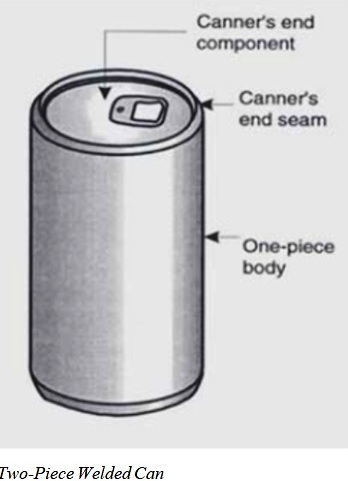History of the Can
The history of the can began in 1975, when Napoleon, leader of the French government, offered a reward to the first person who could devise a way of preserving food for the navy and army. In 1809, Nicolas Appert invents the method of preserving food through sterilization, where he partially cooked the food, sealed it in bottles with cork stoppers, and soaked them in boiled water. In the 1820s, Sir William Edward Parry made journeys across the Northwest passage, taking his canned provisions. As cans traveled across the land, it allowed for can making to spread as well. Around 1812, Thomas Kensett starts a small canning plant in New York, and produced sealed salmon, lobsters, oysters, meats, fruits and vegetables. He first used glass jars, but eventually switched to using tin since glass was more expensive and broke easily. In 1818, Peter Durand introduces the tinplated iron can in America and by 1819, products in tinplate cans are being sold. During the Civil War, soldiers relied heavily on canned provisions and during this time, ways were found to increase the canning process and the production of canned foods increased from five million to almost 30 million. From 1864 to 1920, there was a rapid growth in the can production industry. As the production of cans increased, so did the number of items one could put in these can. By the time of the World Wars, the use of cans became an important part in everyday American life for uses such as soda, paint, pet food, hair spray, and soup. Ways to possibly package carbonated drinks into cans started developing in 1930 and the first aluminum canned beverage was manufactured by Reynolds Metal Company in 1963, who found this metal to be cheaper to use and can be made with as little as two pieces. Other companies, such as Royal Crown and Pepsi, soon started using aluminum to can their beverages as well. One of the most important reasons that aluminum cans had proven to be successful is its recycling value. In 2004, ‘easy open lids’ for cans were praised to be one as one of the top packaging innovations for the past 100 years.
How is Metal Cans Made
Metal Cans can be made out of two or three pieces of metal. For three-piece welded cans, the process starts as steel strip that is cut into large sheets. Then, lacquer is applied to the side of the sheets that will protect the can from corrosion as well as provide a barrier between the product and the metal. The lacquered sheets are then dried in an oven and are cut into smaller sheets. Each sheet will now be for each can body. These sheets are rolled into cylinders and the edges are welded together with an electric current to form a joint, or the side seam. The top and bottom of the cans are then pushed outwards. The bottom end is then sealed to the can it close it off. The cans next go through a beader where the walls of the can have beads formed in them to give them strength. The cans are tested next in a pressure tester that will reject any can with holes or fractures. The can bodies are transferred on pallets to warehouses. The top end is seamed on to the can after the product fills the can.

For two-piece welded food cans, the process with a large steel strip that is lubricated with a liquid and goes through a cupping press, which produces thousands of shallow cups every minute. Each cup gets rammed into a series of rings which gives the cup a smaller diameter, things the wall, and increases the height. Any excess of the cup is removed to the desire height by trimmers and are passed through washers and are dried to remove any left-over lubricant. The cans are coated with a lacquer to protect the can from corrosion and create a barrier between the product and the metal. They are dried in an oven and the top of the can is pushed outwards. Next, they go to a beader where beads are formed to give the can extra strength. The cans are then tested for any holes or fractures and are sent out on pallets to warehouses. The top end is seamed to the can after product has been added to the can. Two-piece welded drink cans are made the same as the food cans, except with few differences. After the cans are trimmed, the cans are coated with a base coat and go to a printer that applies the design on the can and are varnished and dried. Drink cans do not go through a beader either.

Advantages of Using Metal in Packaging
Metal is easy to recycle and is very durable, making it efficient for transportation use. The weight of metal packaging is also very low, so it is efficient for storing and shipping. Many metals can also withstand heat at higher temperatures and is not as frail or expensive as glass.
References
“CanCentral: Everything You Need to Know about Cans.” History of the Can - Can Manufacturers Institute | Washington, DC, www.cancentral.com/can-stats/history-of-the- can.
Figure 1: Zhong, Ji. “Metal Containers.” Packaging Research Institute, www.dplab.sdu.edu.cn/PPTfiles/Packaging/lesson4a-container-metal.pdf.
Figure 2: Zhong, Ji. “Metal Containers.” Packaging Research Institute, www.dplab.sdu.edu.cn/PPTfiles/Packaging/lesson4a-container-metal.pdf.
“How Food and Drink Cans Are Made.” Welcome to MPMA - Metal Packaging Manufacturers Association, www.mpma.org.uk/pages/pv.asp?p=mpma28.
“Metal Cans for Almost Every Need.” Silgan Containers, silgancontainers.com/products/cans/.
“Why Use Metal Cans.” Qorpak, www.qorpak.com/pages/whyusemetalcans.


































